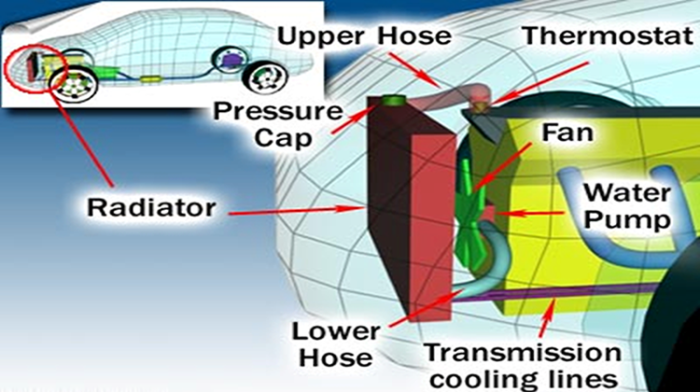Inside your car’s engine, fuel is constantly burning. A lot of the heat from this combustion goes right out the exhaust system, but some of it soaks into the engine, heating it up. The engine runs best when its coolant is about 200 degrees Fahrenheit (93 degrees Celsius). At this temperature:
- The combustion chamber is hot enough to completely vaporize the fuel, providing better combustion and reducing emissions.
- The oil used to lubricate the engine has a lower viscosity (it is thinner), so the engine parts move more freely and the engine wastes less power moving its own components around.
- Metal parts wear less.
There are two types of cooling systems found on cars: liquid-cooled and air-cooled.
Without a cooling system, your engine would quickly reach temperatures that would damage most of its components. Heat damage is one of the leading causes of engine failure. Excessive heat can cause cracking in the engine block, cylinder head and manifold as well as accelerated wear to bearing surfaces in the engine bearings and valve train (The system that allows your engine to “breathe” and includes the camshaft, valves and lifters).
Main Components:
Your car’s cooling system is a complex system consisting of several different parts and subsystems as below:
- Coolant
- Radiator
- Water pump
- Thermostat
- Thermo-time switch
- Thermostat housing
- Electric cooling fan
- Hoses
Heating System & Heating Plumbing:
You may have heard the advice that if you car is overheating, open all the windows and run the heater with the fan going at full blast. This is because the heating system is actually a secondary cooling system that mirrors the main cooling system on your car.
The heater core, which is located in the dashboard of your car, is really a small radiator. The heater fan blows air through the heater core and into the passenger compartment of your car.
The heater core draws its hot coolant from the cylinder head and returns it to the pump — so the heater works regardless of whether the thermostat is open or closed.
Repair Costs for Common Problems
Repair costs for cooling system are determined by the model, year and vehicle manufacturer. Moreover, there are differences between rear wheel drive vehicles, front wheel drive vehicles, trucks, SUVs and different sized passenger vehicles. You will sometimes pay a higher cost for the same type of repair simply because you drive a luxury vehicle, whose repair parts are higher priced.
Since the cost of repair parts are tied to the type of vehicle you own, the best way to determine the cost for a repair job is to compare hourly labor rates and labor time to fix the problem.


